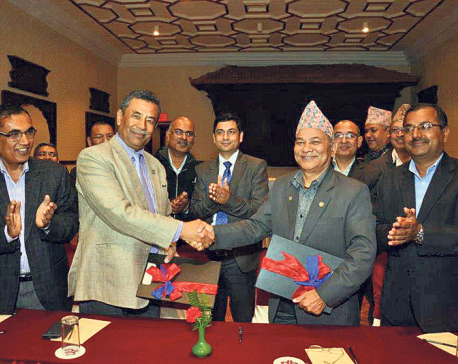
OR
NRB, World Bank differ on impact of fiscal transfers, recent floods
Published On: September 24, 2017 07:15 AM NPT By: Sagar Ghimire | @sagarghi
KATHMANDU, Sept 24: While the World Bank has recently revised its economic growth forecast for Nepal down to 4.6 percent for the current Fiscal Year 2017/18, partly due to the impact by recent floods, Nepal Rastra Bank (NRB) has, however, played down such worries.
In contrast to the World Bank’s recent report that has concluded that the economic activity, which was expected to progress well in FY2018, has been set back by another natural disaster, the central bank said that the loss resulting from the widespread floods and inundation is ‘likely to be less than initially feared’.
“The greater loss of farm output on account of widespread floods and inundation caused by heavy rains of mid-August 2017 is likely to be less than initially feared,” read the Current Macroeconomic and Financial Situation of Nepal (Based on First Month’s Data of 2017/18).
“The torrential rains did cause the stock loss including agricultural infrastructures in most of districts of Terai region. However, the timely onset of monsoon, the normal rainfall in subsequent period, improved supply of agricultural inputs and the steps taken by the government are likely to offset the output loss initially assumed,” it added.
Releasing its ‘Nepal Development Update’, a semi-annual publication on key economic development of the country, the World Bank projected the economy to grow by 4.6 percent in the current fiscal year, far lower than the government’s target of 7.2 percent.
While the NRB has painted a rosy picture of the macroeconomic outlook in its monthly report, it has remained silent whether the government’s target of 7.2 percent is achievable.
While the central bank has not provided any data or its assessment about the losses from the floods, the World Bank has said that the estimates of destroyed crops in 64,000 hectares of land will likely lead to a weak agricultural output in the current fiscal year.
Similarly, the World Bank and the central bank also seemed to have differing outlooks on the impact of the fiscal transfers to the sub-national governments in the budget of 2017/18. The NRB seemed to be optimistic that such fiscal transfers of a whopping Rs 225 billion to local levels along with successful conclusion of local elections are expected to boost capital spending and spur economic activities.
However, the World Bank is little convinced with the government’s commitment of budget implementation. Instead, the multilateral donor warns that the lack of clarity regarding the fiscal architecture in the federal structure ‘can cause unintended interruptions in service delivery and execution of capital projects’.
“An overly ambitious budget has continued into FY2018 as well which is going to pose a challenge because of the lack of clarity around spending in the federal structure and several upcoming elections,” read the World Bank’s biannual report that has a special focus this time on fiscal architecture for federal set-up.
You May Like This

World Bank projects 7.5% growth for this fiscal year
KATHMANDU, May 11: Nepal is set to record highest economic growth in 23 years in the current fiscal year, according to... Read More...

World Bank giving $100m to strengthen financial sector
KATHMANDU, Mar 4: The World Bank has approved a US$ 100 million credit to help Nepal accelerate its medium-term reform program... Read More...

Janata Bank, Tribeni Bikas Bank sign merger pact
KATHMANDU, Nov 8: Janata Bank Nepal Ltd and Triveni Bikas Bank Ltd have signed a memorandum of understanding (MoU) for... Read More...
Just In
- KMC to organize a month-long skill fair from May 1
- Birgunj Metropolis collects over Rs 360 million in revenue
- NEPSE plunges below 2,000 points after one and a half months; daily turnover declines to Rs 2.10 billion
- AI Index Report-2024: AI still behind humans on complex tasks like competition-level mathematics
- Daiji-Jogbudha road construction at snail’s pace
- Govt fails to adopt podway technology despite its potential in Nepal
- Jhulaghat border crossing in Baitadi to remain closed from this evening
- Universities will be free from partisan interests: Education Minister


















Leave A Comment